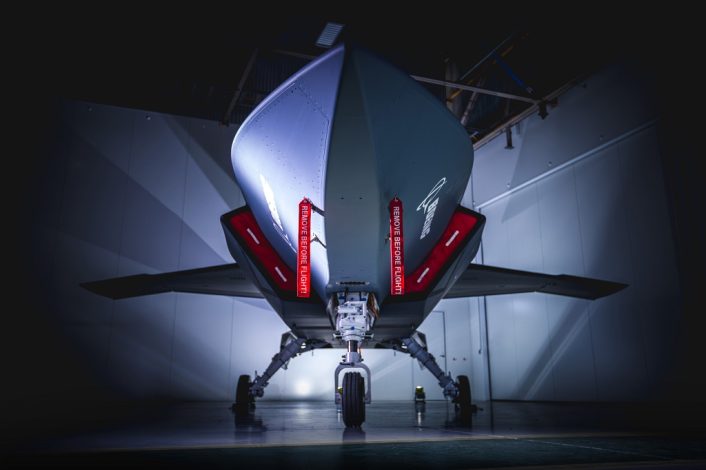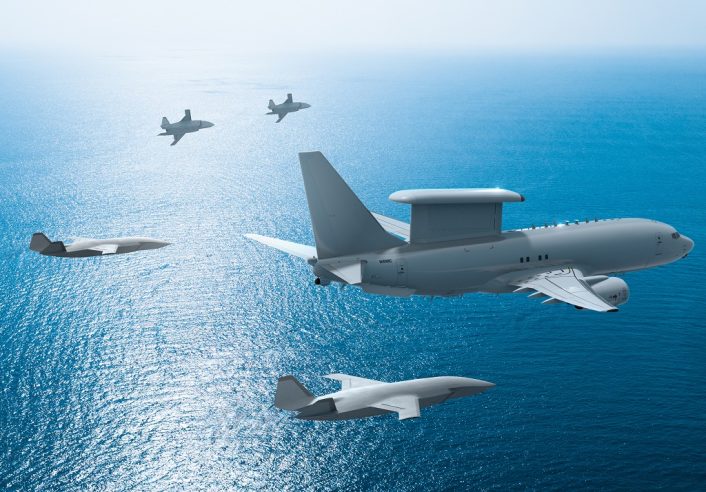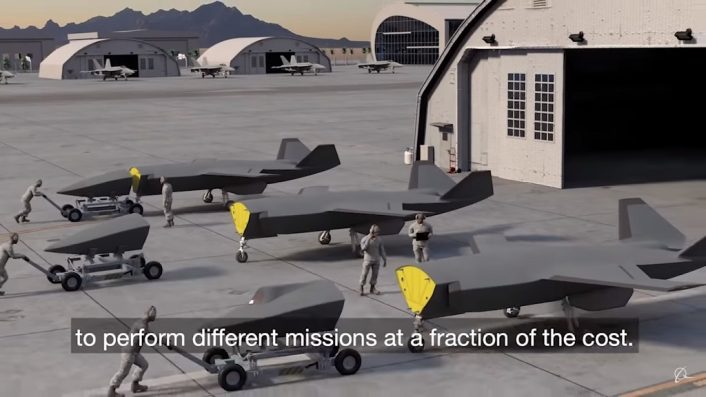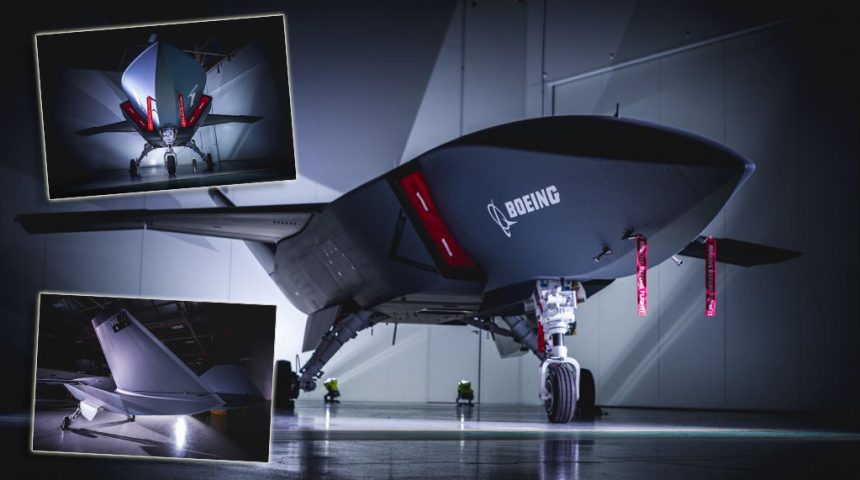The Airpower Teaming System will fly on its own with minimum pilot’s input thanks to Artificial Intelligence
Boeing rolled out its first Airpower Teaming System (ATS) unmanned aircraft developed for the Loyal Wingman Advanced Development Program of the Royal Australian Air Force (RAAF) during a ceremony on May 5, 2020. This drone is the first clean-sheet design created by Boeing outside the United States and also the first RAAF’s clean-sheet design in more than 50 years. The development work is reportedly undergoing in Brisbane, where Boeing Australia is based.
The program moved pretty quickly since the ATS was first unveiled during the Avalon Airshow in February 2019, with the first fuselage completed in February 2020 and the first power on, with the aircraft on its wheels, in April. The Australian government contributed with an investment of 40 million AUD (USD 25.7 million), while Boeing’s financial involvement in not specified.
We’re proud to be part of the #LoyalWingman unmanned aircraft program. The 1st prototype of the 1st military aircraft to be designed & built in Australia in more than 50 years was unveiled today by @BoeingAustralia.
Find out more at https://t.co/QzgQnYN6DU#AusAirForce #UAV pic.twitter.com/jpTTaHNu1c
— Royal Australian Air Force (@AusAirForce) May 5, 2020
“This project is an excellent example of innovation through collaboration and what can be achieved working together with defence industry. This demonstrates the importance of the relationship Air Force has with Boeing Australia and defence industry more broadly. I look forward to exploring the capabilities this aircraft may bring to our existing fleet in the future”, said Air Marshal Mel Hupfeld, Chief of the Royal Australian Air Force.

The aircraft is 38 ft long (11.7 m) with a twin tail configuration and wings reminiscent of the jet-powered Predator C, although with a much shorter wingspan. Not much is known about the powerplant, except for the drone being powered by a business jet-class engine.
According to the company, the ATS will perform/support Intelligence, Surveillance and Reconnaissance (ISR), tactical early warning and other unspecified missions, teaming up with the E-7 Wedgetail, P-8 Poseidon, F/A-18E/F Super Hornet, EA-18G Growler and F-35A Lightning II in service with the RAAF. Actually, the Super Hornets depicted with the ATS in the media kit are Block III, the first of which (even if without some of the upgrades) has been recently delivered to the U.S. Navy, but it’s not yet confirmed if the RAAF will perform the upgrade or will keep the jets in the Block II configuration.
The first #FA18 Block III #SuperHornet test jet has rolled out of final assembly. Two of these test jets will head to the @USNavy, where they’ll help pilots familiarize themselves with the updated jets and be used in carrier flight tests. pic.twitter.com/ojmn7Uy4Z0
— Boeing Defense (@BoeingDefense) May 8, 2020
The media kit shows the ATS flying also with advanced versions of the F-15 Eagle and with the F-22 Raptor, suggesting a broader integration with other non-Australian aircraft. The only details provided about the flight characteristics are a 2000 nm (3700 km) range and fighter-like performance.

The ATS will be flown by Artificial Intelligence (AI) and controlled from the back seat of a Super Hornet or a Growler for smaller formations, or from a control station aboard a Wedgetail or a Poseidon. Boeing didn’t provide details on how the AI specifically works, but explained that the controller will simply signal the mission intent to the Loyal Wingman and the AI will figure out by itself mission specifics and navigation, while keeping a safe separation from other manned and unmanned aircraft. According to the company, the manned-unmanned teaming system retrofit for the controlling aircraft is low cost and does not require significant modifications.
Part of the Artificial Intelligence (AI) teaming development for the ATS was also achieved high-performance scale radio-controlled jets that were able to fly up to 300 km/h while safely communicating and coordinating with each other, starting with simple task with just two aircraft and then moving to more complex tasks and more aircraft involved.
We successfully achieved our first autonomous teamed flights using high-performance jets as test beds and Australian-developed mission systems technology. #AirpowerTeaming pic.twitter.com/lOFGgY0Y67
— Boeing Australia (@BoeingAustralia) November 19, 2019
Boeing is building a total of three ATS prototypes for Australia using automated production systems to also validate the concept for the full-rate production line. The aircraft itself is more than just a prototype, as it will include also all the required systems to demonstrate its capabilities and develop Loyal Wingman procedures and tactics. The company used a “digital twin” of the ATS to develop structure, systems and life-cycle requirements before physically building the prototype by employing resin-infusion techniques that were developed for the Boeing 787. By using these techniques, Boeing created its largest-ever resin infused single-piece composite structure, which is one of the two halves that form the drone’s wing. If you want to know more about what can be accomplished by using a “digital twin”, you can read how the U.S. Air Force applied the concept to the B-1 bomber.
Australian industries are working with Boeing on the ATS program and helped the rapid development, including BAE Systems Australia, RUAG Australia, Ferra Engineering and AME Systems. BAE Systems, which worked with Boeing for more than 30 years, provided flight control computers, navigation equipment and UAV management and simulation systems. RUAG supplied the drone’s landing gear, as the company is since 2001 the landing gear supplier for Super Hornet, Wedgetail, Chinook and other Boeing aircraft. Ferra Engineering and AME Systems provided precision machine components and wiring looms, respectively.

While the Loyal Wingman is designed primarily for the RAAF, the final version of the ATS will be destined to the global defense market and custom tailored to the client’s own defense and industrial objectives. “We are proud to take this significant step forward with the Royal Australian Air Force and show the potential for smart unmanned teaming to serve as a force multiplier. We look forward to getting the aircraft into flight testing and proving out the unmanned teaming concept. We see global allies with those same mission needs, which is why this program is so important to advancing the development of the Boeing Airpower Teaming System”, said Kristin Robertson, Vice President and General Manager of Autonomous Systems for Boeing.
One of the key features of the ATS is an 8.5 ft (2.6 m) long modular nose cone with 9000 cubic inches internal volume to house different payloads. The entire nose can by swapped quickly according to the mission’s needs and also to the customer’s needs.
Our friends at The War Zone were among the journalist that were able to talk with the masterminds behind the project, Jerad Hayes, Senior Director of Autonomous Aviation and Technology, and Dr. Shane Arnott, Program Director of Airpower Teaming System. The team explained that the ATS has been designed with low-observable features that are balanced with performance and affordability. They also noted that they decided not to use a flying wing because this more complex solution would be more expensive and unforgiving to fly, while the chosen design is relatively simple and has some maneuverability tricks that will make it satisfy a wide range of operational requirements.
The ATS will undergo ground and taxi testing before the first flight by the end of the year in Australia, as confirmed by Dr. Arnott: “Following factory acceptance of the aircraft, it will go into taxi testing in advance of first flight, which will take place in 2020 in Australia – beyond that, we’re not offering specific dates or the locations of the flight”. The following tests will be used by Boeing and the RAAF to determine the best way to integrate the manned-unmanned teaming in new tactics that will reduce risks for the pilots during combat.
Boeing didn’t provide a price tag for the ATS, but specified that they designed the system as a cheap, flexible and attritable aircraft, supposedly keeping it competitive with the XQ-58 Valkyrie produced by Kratos Defense and Security, which has a 2-3 million USD price tag.
The U.S. Air Force is currently evaluating the XQ-58 Valkyrie for a possible loyal wingman role and as communication relay platform for the F-22 and F-35. Boeing is involved in talks with the U.S. Department of Defense to understand the specific mission needs and requirements for a potential ATS offer.
Back in February, Boeing and the U.S. Navy tested the manned-unmanned teaming also by flying two “unmanned” EA-18Gs Growlers from the backseat of a third one. The aircraft performed 21 different missions during four flights. While not officially stated, the results of the test may have applied to the ATS and its manned-unmanned teaming system interface and, maybe, to determine how much the U.S. Navy and the Department of Defense may be interested in the loyal wingman proposed by Boeing.









